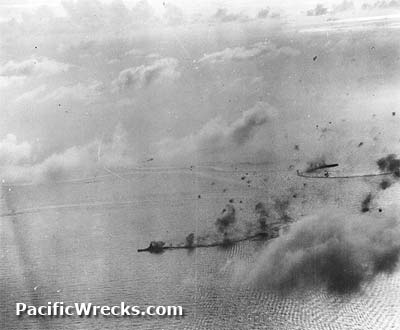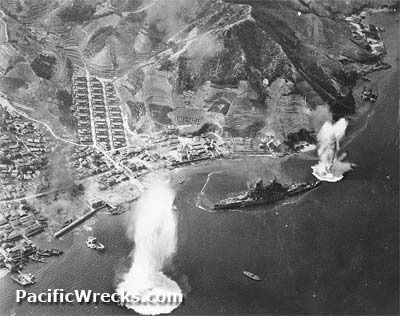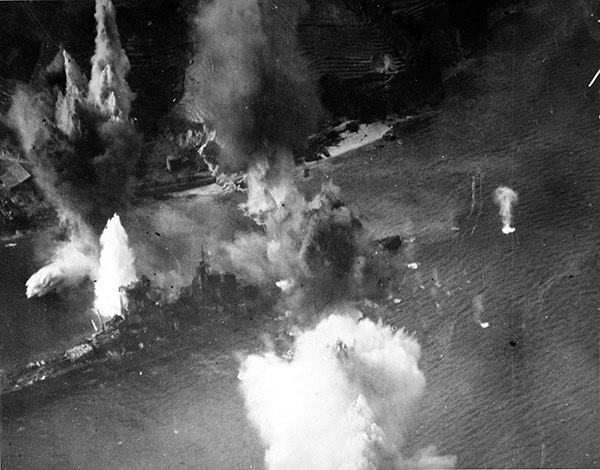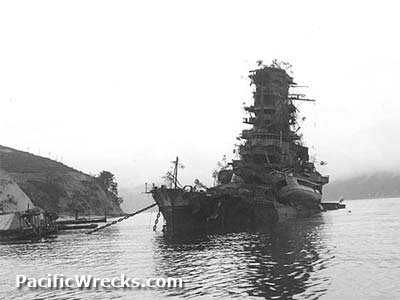|
|
|
| Missing In Action (MIA) | Prisoners Of War (POW) | Unexploded Ordnance (UXO) |
| Chronology | Locations | Aircraft | Ships | Submit Info | How You Can Help | Donate |
|
| IJN Kongō Class Battlecruiser 37,187 Tons 728' 4" x 101' 8" x 31' 10" 8 × 14" 16 × 152mm 8 × 127mm 118 × 25mm 4 × 13.2mm 4 × 21" torpedo tubes  USN June 20, 1944   USN July 28, 1945  USN October 8, 1945 |
Ship History Built by Kawasaki Shipyards in Kobe. Designed by Vickers naval architect Sir George Thurston as the fourth Kongō-class battlecruiser designed for Japan. The Kongō-class battlecruisers included Kongō, Hiei, Kirishima, and Haruna. Laid down March 16, 1912 as a Kongō-class battlecruiser. Due to a shortage of slipways, Kirishima and Haruna were the first two warships of the Japanese built in private Japanese shipyards. L Launched December 14, 1913 as Haruna 榛名, named after Mount Haruna, an active volcano in Gunma Prefecture on Honshū in Japan. Commissioned April 19, 1915 in the Imperial Japanese Navy (IJN). World War I Service During World War I, operated in the Pacific. During 1917 while in the South Pacific, possibly damaged by a sea mine laid by Kaiserliche Marine (Imperial German Navy) Auxilliary Cruiser SMS Wolf or light cruiser SMS Berlin. In 1927-28, she was modernized at Yokosuka Dockyard, emerging with only two smokestacks and a new forward superstructure, as well as with improved armament and protection. Reclassified thereafter as a battleship, Haruna was again modernized in 1933-34, this time at Kure Dockyard, raising her standard displacement to over 32,000 tons and giving her a quite up-to-date appearance. More powerful machinery and a lengthened hull gave the reconstructed ship a speed of thirty knots, making her a very useful battleship, though relatively lightly armed and armored. World War II Service During December 1941 covered the invasion of Malaya. The first four months of 1942, Haruna supported the conquest of the Netherlands East Indies (NEI). On March 1, 1942 in the Banda Sea proceeds via the Ombai Strait off Timor bound for Christmas Island. On March 7, 1942 Kongo and Haruna plus destroyers Urakaze, Hamakaze, Isokaze and Tanikaze bombard Christmas Island. Afterwards, participates in the Indian Ocean Raid. On May 29, 1942 assigned to Operation MI as part of Vice-Admiral Chūichi Nagumo's carrier strike force with Kirishima and steams eastward bound for Midway Atoll. On June 4, 1942 at 4:30am at the start of the Battle of Midway launches her Dave floatplane to seach to the northeast without results.At 8:17am atacked by eleven SB2U-3 Vindicator from VMSB-241 that score several near misses and claim five shot down by anti-aircraft fire without sustaining damaged. At 10:20am a pair of SBD Dauntless dive bombers from USS Yorktown approach the starboard beam and score two near misses that cause waterspouts that other warships in mistake for hits. At 6:49pm a formation of eight B-17s bomb the warships. A pair of B-1E Flying Fotresses piloted by Lt. Wuertele and Lt. Grundman bomb Haruna and claim hits. In fact, only one near miss was scored near the stern causing light damage including bent plates and jammed the main battery's range finder. On June 5, 1942 at 4:00pm Haruna is bombed by SBDs and suffers only minor damage. During the night, the strike force joins the main body, the withdraw westward. On June 14, 1942 returns Hashirajima and six days later assigned to Captain Keishi Ishii. On July 14, 1942 assigned to the 2nd Fleet and equipped with E8N2 Dave floatplanes. On July 25, 1942 arrives Kure for repairs and refit over the next four days. On September 6, 1942 departs Kure bound for Truk and joins the rest of the 3rd Battleship Diviosn. On September 10, 1942 departed as part of the Second Fleet under the command of Admiral Kondō to the north Solomon Islands and refuels at sea. On September 18, 1942 again sorties to the Solomon Islands but two days later is recalled to Truk. On September 23, 1942 returns Truk. On October 11, 1942 departs Truk bound for the Solomon Islands with the Second Fleet and Third Fleet. On October 12, 1942 in the northern Solomon Islands, the battleships are escorted by Isuzu and destroyers then on October 13, 1942 proceed southward down "The Slot" to Guadalcanal. Bombardment of Henderson Field On October 14, 1942 at 1:33am floatplanes release flares to mark Henderson Field on Guadalcanal. At 1:37am Kongō opens fire joined shortly after by Haruna to commence a shore bombardment of Henderson Field on Guadalcanal firing a total of 918 shells. Kongō fired 435 shells and Haruna fired 483 shells. During the bombardment, Isuzu and destroyers provide covering firing targeting shore batteries. The force steams eastward passing Lunga Point firing to starboard, then made a 180 degree turn and fires to port while departing. On the ground, the shelling damaged the two runways, burned fuel and destroyed 48 parked planes and resulted in 41 KIA. Although PT Boats attempt to intercept, they are driven away by Naganami. At 2:30am the force retires northward up "The Slot" at 29 knots. On October 17, 1942 refuels at sea. On October 26, 1942 during the Battle of the Santa Cruz Islands (Battle of the South Pacific) attacked by a PBY Catalina without damage. On October 30, 1943 returns to Truk. On November 9, 1942 departs Truk with Japanese aircraft carrier Junyo and cruiser Tone and light cruiser Sendai and five destroyers. On November 13, 1942 force during Naval Battle of Guadalcanal operating near Ontong Java. On November 15, 1942 departs for Truk arriving three days later. For the remainder of the month, undergoes training exercises. Afterwards, she steamed north to Japan in May 1943 in response to the American landings on Attu and was in the central Pacific later in the year during the invasions of the Gilbert Islands and Bougainville. Battle of the Philippine Sea In mid-June 1944, however, the Japanese fleet was sent to counterattack the U.S. forces then assaulting Saipan. As part of the heavily-defended van carrier group, participated in the Battle of the Philippine Sea. On June 20, 1944 hit by a bomb. Battle of Leyte Gulf and Battle off Samar Haruna participated in the Battle of Leyte Gulf. On October 24, 1944 damaged by bomb near-misses in the Sibuyan Sea, but steamed on to engage U.S. escort carriers and destroyers the next day for the Battle off Samar. On December 11, 1944 departs Sasebo escorted by destroyers Fuyutsuki and Suzutsuki and the next day arrives at Kure. On December 20, 1944 assigned to Captain Yoshimura Matake. While being repaired at Kure Harbor, her gun turrets are painted with gray stripes as camouflage. On January 1, 1945 while at Kure, BatDiv 3 is deactivated and assigned instead assigned to BatDiv 1, 2nd Fleet. On February 10, 1945 BatDiv 1 is deactivated and assigned to the Kure Naval District. On March 19, 1945 anchored at Etajima Bight in Kure Harbor when U.S. Navy (USN) Task Force 58 (TF-58) carrier aircraft attack Kure. and was hit by a bomb on the starboard side aft of the bridge and sustains only slight damage. Sinking History On July 28, 1945 U.S. Navy (USN) Task Force 38 (TF-38) carrier planes and B-24 Liberators from the 7th Air Force more bomb hits that cause the battleship to sink into shallow water inside Kure Harbor. Shipwreck Haruna settled in shallow water. Postwar, the shipwreck was scrapped. References Combined Fleet - IJN Battleship Haruna: Tabular Record of Movement Marines in World War II Historical Monograph The Guadalcanal Campaign Chapter VII: Expansion to the West and The October Attack on the Airfield pages 110-111 "Later the same night, a strong attack was made upon the American positions. The battleships Kongo and Haruna, screened by light cruiser Isuzu and eight destroyers, rained a continuous fire upon the airfield and the fighter strip for a period of 80 minutes.13 Flares from observation and spotting planes illuminated the area, and the fire was accurate and heavily damaging. The scout-bomber aircraft suffered heavily, and the close of the action found only one SBD in operating condition. Forty-one dead were suffered, with many wounded (footnote 14: Final Report, Phase V, p. 16)." History of the Marine Corps Aviation in World War II (1952) pages 98-100 (The Big Bombardment) Fortress Against The Sun (2001) page 192 Contribute
Information Last Updated
|
Map July 24, 1945 Warship Targets |
| Discussion Forum | Daily Updates | Reviews | Museums | Interviews & Oral Histories |
|